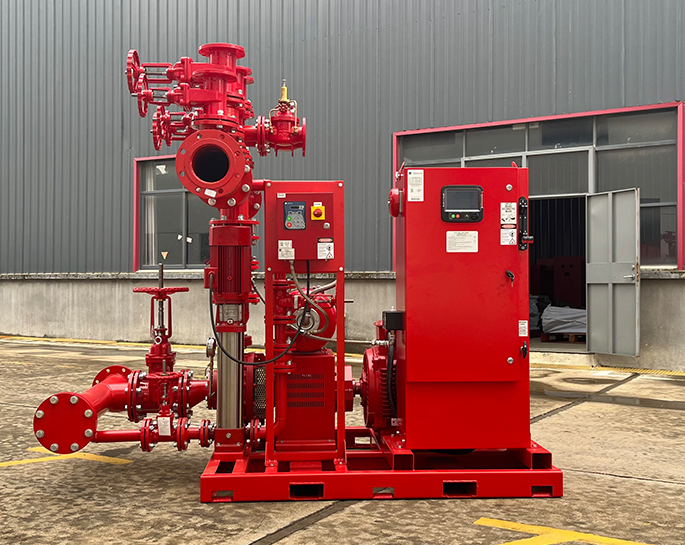What are some common challenges or issues encountered with firefighting pumps?
Feb 19, 2024
Share:
Several common challenges or issues can be encountered with firefighting pumps. These challenges can vary depending on factors such as the type of pump, its age, maintenance history, and the operating conditions. Some common challenges include:
1. **Cavitation**: Cavitation occurs when the pressure in the pump drops below the vapor pressure of the liquid being pumped, causing vapor bubbles to form and collapse within the pump. This can lead to damage to the pump components and reduced pump efficiency.
2. **Overheating**: Firefighting pumps can overheat due to prolonged operation or inadequate cooling. Overheating can lead to damage to pump seals, bearings, and other components, reducing the pump's effectiveness and lifespan.
3. **Corrosion and Erosion**: Exposure to water, chemicals, and other harsh environments can cause corrosion and erosion of pump components over time. This can lead to leaks, reduced pump performance, and eventual pump failure if not addressed through proper maintenance and material selection.
4. **Mechanical Failures**: Mechanical failures such as bearing failures, seal failures, and shaft misalignment can occur due to wear and tear, inadequate lubrication, or improper installation. These failures can result in pump downtime and the need for costly repairs.
5. **Blockages and Debris**: Firefighting pumps can become clogged or blocked by debris such as leaves, dirt, or foreign objects sucked in from water sources. Blockages can impede the flow of water and reduce pump performance, requiring manual clearing or maintenance.
6. **Electrical Issues**: Electric firefighting pumps may experience electrical issues such as motor failures, wiring faults, or power supply issues. These issues can result in pump malfunction or failure, requiring troubleshooting and repair by qualified technicians.
7. **Maintenance Challenges**: Proper maintenance is essential for ensuring the reliable operation of firefighting pumps. However, challenges may arise due to inadequate maintenance practices, limited access to equipment, or insufficient resources for maintenance activities.
Addressing these challenges requires proactive maintenance, regular inspections, proper training for personnel, and adherence to manufacturer recommendations and industry best practices. Additionally, selecting the right pump for the specific application and ensuring proper installation can help mitigate potential issues and maximize pump performance and longevity.

1. **Cavitation**: Cavitation occurs when the pressure in the pump drops below the vapor pressure of the liquid being pumped, causing vapor bubbles to form and collapse within the pump. This can lead to damage to the pump components and reduced pump efficiency.
2. **Overheating**: Firefighting pumps can overheat due to prolonged operation or inadequate cooling. Overheating can lead to damage to pump seals, bearings, and other components, reducing the pump's effectiveness and lifespan.
3. **Corrosion and Erosion**: Exposure to water, chemicals, and other harsh environments can cause corrosion and erosion of pump components over time. This can lead to leaks, reduced pump performance, and eventual pump failure if not addressed through proper maintenance and material selection.
4. **Mechanical Failures**: Mechanical failures such as bearing failures, seal failures, and shaft misalignment can occur due to wear and tear, inadequate lubrication, or improper installation. These failures can result in pump downtime and the need for costly repairs.
5. **Blockages and Debris**: Firefighting pumps can become clogged or blocked by debris such as leaves, dirt, or foreign objects sucked in from water sources. Blockages can impede the flow of water and reduce pump performance, requiring manual clearing or maintenance.
6. **Electrical Issues**: Electric firefighting pumps may experience electrical issues such as motor failures, wiring faults, or power supply issues. These issues can result in pump malfunction or failure, requiring troubleshooting and repair by qualified technicians.
7. **Maintenance Challenges**: Proper maintenance is essential for ensuring the reliable operation of firefighting pumps. However, challenges may arise due to inadequate maintenance practices, limited access to equipment, or insufficient resources for maintenance activities.
Addressing these challenges requires proactive maintenance, regular inspections, proper training for personnel, and adherence to manufacturer recommendations and industry best practices. Additionally, selecting the right pump for the specific application and ensuring proper installation can help mitigate potential issues and maximize pump performance and longevity.


.png)
.png)

.png)


